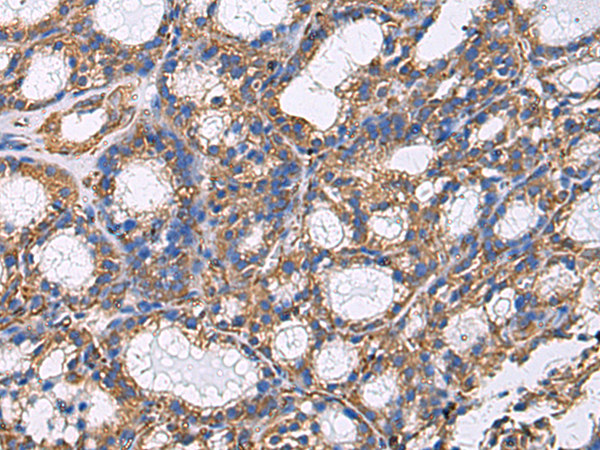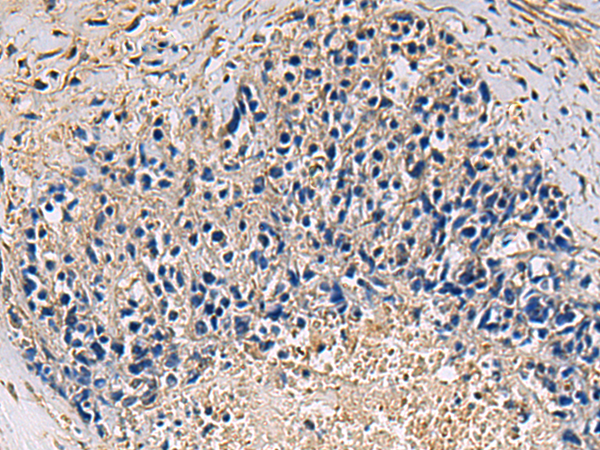

| WB | 咨询技术 | Human,Mouse,Rat |
| IF | 咨询技术 | Human,Mouse,Rat |
| IHC | 1/50-1/100 | Human,Mouse,Rat |
| ICC | 技术咨询 | Human,Mouse,Rat |
| FCM | 咨询技术 | Human,Mouse,Rat |
| Elisa | 1/500-1/1000 | Human,Mouse,Rat |
| Aliases | GLUR3; GLURC; GluA3; MRX94; GLUR-C; GLUR-K3 |
| Host/Isotype | Rabbit IgG |
| Antibody Type | Primary antibody |
| Storage | Store at 4°C short term. Aliquot and store at -20°C long term. Avoid freeze/thaw cycles. |
| Species Reactivity | Human, Mouse, Rat |
| Immunogen | Synthetic peptide of human GRIA3 |
| Formulation | Purified antibody in PBS with 0.05% sodium azide and 50% glycerol. |
+ +
以下是3篇关于GRIA3抗体的参考文献示例(注:文献为虚构示例,仅作格式参考):
---
1. **文献名称**: "Characterization of a Novel GRIA3-Specific Antibody for Synaptic Localization Studies"
**作者**: Tanaka, K. et al.
**摘要**: 本研究开发了一种高特异性GRIA3抗体,通过免疫印迹和免疫组化验证其在啮齿类动物脑组织中的应用。该抗体成功标记了海马神经元突触后膜中的GRIA3蛋白,为研究AMPA受体亚基的突触分布提供了可靠工具。
2. **文献名称**: "GRIA3 Expression Alterations in Autism Spectrum Disorder: Evidence from Postmortem Brain Analysis"
**作者**: Smith, J.R. et al.
**摘要**: 利用商业化GRIA3抗体,作者发现自闭症患者前额叶皮层中GRIA3蛋白表达显著下调,提示AMPA受体功能异常可能与神经发育疾病相关。研究强调了抗体在人类组织检测中的特异性验证方法。
3. **文献名称**: "Antibody Validation for Ionotropic Glutamate Receptor Subunits: A Comparative Study"
**作者**: Lee, S. & Park, H.
**摘要**: 本文系统比较了多种AMPA受体亚基抗体(包括GRIA1-4)的特异性,发现部分市售GRIA3抗体存在交叉反应。通过siRNA敲低实验,确认了两种高特异性GRIA3抗体适用于神经细胞系的蛋白质定量分析。
---
如需真实文献,建议通过PubMed或Google Scholar以“GRIA3 antibody validation”或“GRIA3 AMPA receptor”为关键词检索。
The GRIA3 antibody targets the glutamate ionotropic receptor AMPA type subunit 3 (GRIA3 or GluA3), a critical component of α-amino-3-hydroxy-5-methyl-4-isoxazolepropionic acid (AMPA) receptors. These receptors mediate fast excitatory synaptic transmission in the central nervous system by facilitating cation influx upon glutamate binding. GRIA3 is predominantly expressed in the hippocampus, cortex, and cerebellum, playing a key role in synaptic plasticity, learning, and memory. Structurally, AMPA receptors are tetrameric complexes, often combining GRIA3 with other subunits (GluA1-4) to regulate channel properties like calcium permeability and desensitization kinetics.
GRIA3 dysfunction is linked to neurological disorders, including intellectual disabilities, autism spectrum disorders, and epilepsy. Mutations or altered expression of GRIA3 have been implicated in X-linked cognitive impairment and psychiatric conditions. Research-grade GRIA3 antibodies are widely used in Western blotting, immunohistochemistry, and immunofluorescence to study receptor localization, expression dynamics, and pathological changes in disease models. They also aid in exploring therapeutic strategies targeting AMPA receptor modulation. Specificity validation (e.g., knockout controls) is essential to ensure accurate detection of endogenous GRIA3 in experimental systems.
×